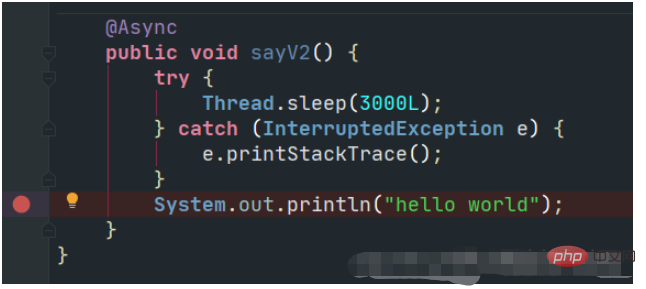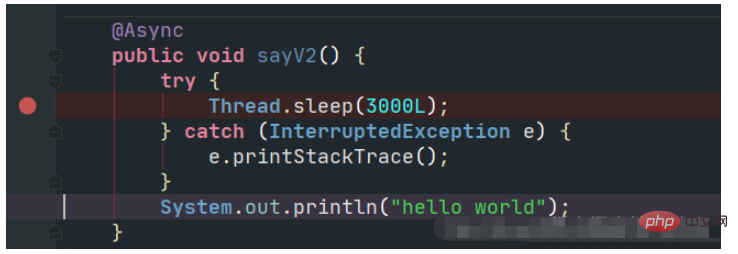Java asynchronous task implementation and analysis
1. What is an asynchronous task
Whether it is in life or in a program, it can be roughly divided into two types: synchronous and asynchronous.
Synchronization: For example, if you go to eat Haidilao, you have to order the bottom of the pot first, then the dishes, then the waiter brings the bottom of the pot, then the dishes, and finally you can eat the dishes. This process must be done in order. .
Asynchronous tasks: Let’s go eat Haidilao. There are many people eating. There are many people in front of you. You may have to queue up and wait until you are in line before you can enter the restaurant. But what if you want to go to the toilet halfway? You have to queue up again when you come back. So there is a call system. You queue up to get a number first, and then you can go get a massage, watch a movie, go to the spa, buy a cup of milk tea... It's finally your turn. At this time, you will be notified that you are in line, and then you can enter. This process is asynchronous.
2. SpringBoot Async
At first I thought about opening a thread pool and throwing the tasks into the thread pool to complete.
Later I remembered that SpringBoot has a more convenient asynchronous framework Async
The code is also very simple. You only need to add @Async to the method that needs asynchronous execution, and add @EnableAsync to the SpringBoot startup class. That’s it
@Async
public void task() {
// do something
}3. Pitfall diary
Although the code is small, the pitfalls will not decrease as the amount of code decreases.
For the sake of convenience, I built a demo locally and directly uploaded the code
@RestController
public class AsyncController {
@Autowired
private AsyncService asyncService;
@GetMapping("/v1/say")
public String sayV1() {
asyncService.sayV1();
return "success1";
}
@GetMapping("/v2/say")
public String sayV2() {
asyncService.sayV2();
return "success2";
}
}@Service
public class AsyncService {
public void sayV1() {
try {
Thread.sleep(3000L);
} catch (InterruptedException e) {
e.printStackTrace();
}
System.out.println("hello world");
}
@Async
public void sayV2() {
try {
Thread.sleep(3000L);
} catch (InterruptedException e) {
e.printStackTrace();
}
System.out.println("hello world");
}
}It is a very simple demo that provides two interfaces, /v1/say and /v2/say, one for synchronous execution , an asynchronous execution that simulates time-consuming tasks by sleeping for 3 seconds
Start normally without any problems. If it is executed synchronously, wait 3 seconds before the main thread will return. If it is executed asynchronously, it will return immediately and wait 3 seconds. Helloworld
will be output. However, when I added a breakpoint, a problem occurred.
I first added a breakpoint on the line that prints hello world. The effect is the same as the original one, except that it is blocked before printing, but it does not affect the return of the main thread.

Edit
But when I added a breakpoint where the method came in, I found that the main thread was actually blocked!

Edit
4. Solve
Various problem solving, @Async does not take effect, asynchronous tasks wait for the main thread to return, nothing happens Find effective solutions.
Later, a colleague reminded me, could it be a thread blocked by the debug function?
With the attitude of giving it a try, I found the debug configuration

Edit
The breakpoint can choose to block the jvm Or block the current thread. The default is to block the jvm.
Select suspend to Thread, and the main thread will no longer be blocked
The above is the detailed content of Java asynchronous task implementation and analysis. For more information, please follow other related articles on the PHP Chinese website!

Hot AI Tools

Undresser.AI Undress
AI-powered app for creating realistic nude photos

AI Clothes Remover
Online AI tool for removing clothes from photos.

Undress AI Tool
Undress images for free

Clothoff.io
AI clothes remover

Video Face Swap
Swap faces in any video effortlessly with our completely free AI face swap tool!

Hot Article

Hot Tools

Notepad++7.3.1
Easy-to-use and free code editor

SublimeText3 Chinese version
Chinese version, very easy to use

Zend Studio 13.0.1
Powerful PHP integrated development environment

Dreamweaver CS6
Visual web development tools

SublimeText3 Mac version
God-level code editing software (SublimeText3)

Hot Topics
 1386
1386
 52
52
 Perfect Number in Java
Aug 30, 2024 pm 04:28 PM
Perfect Number in Java
Aug 30, 2024 pm 04:28 PM
Guide to Perfect Number in Java. Here we discuss the Definition, How to check Perfect number in Java?, examples with code implementation.
 Weka in Java
Aug 30, 2024 pm 04:28 PM
Weka in Java
Aug 30, 2024 pm 04:28 PM
Guide to Weka in Java. Here we discuss the Introduction, how to use weka java, the type of platform, and advantages with examples.
 Smith Number in Java
Aug 30, 2024 pm 04:28 PM
Smith Number in Java
Aug 30, 2024 pm 04:28 PM
Guide to Smith Number in Java. Here we discuss the Definition, How to check smith number in Java? example with code implementation.
 Java Spring Interview Questions
Aug 30, 2024 pm 04:29 PM
Java Spring Interview Questions
Aug 30, 2024 pm 04:29 PM
In this article, we have kept the most asked Java Spring Interview Questions with their detailed answers. So that you can crack the interview.
 Break or return from Java 8 stream forEach?
Feb 07, 2025 pm 12:09 PM
Break or return from Java 8 stream forEach?
Feb 07, 2025 pm 12:09 PM
Java 8 introduces the Stream API, providing a powerful and expressive way to process data collections. However, a common question when using Stream is: How to break or return from a forEach operation? Traditional loops allow for early interruption or return, but Stream's forEach method does not directly support this method. This article will explain the reasons and explore alternative methods for implementing premature termination in Stream processing systems. Further reading: Java Stream API improvements Understand Stream forEach The forEach method is a terminal operation that performs one operation on each element in the Stream. Its design intention is
 TimeStamp to Date in Java
Aug 30, 2024 pm 04:28 PM
TimeStamp to Date in Java
Aug 30, 2024 pm 04:28 PM
Guide to TimeStamp to Date in Java. Here we also discuss the introduction and how to convert timestamp to date in java along with examples.
 Java Program to Find the Volume of Capsule
Feb 07, 2025 am 11:37 AM
Java Program to Find the Volume of Capsule
Feb 07, 2025 am 11:37 AM
Capsules are three-dimensional geometric figures, composed of a cylinder and a hemisphere at both ends. The volume of the capsule can be calculated by adding the volume of the cylinder and the volume of the hemisphere at both ends. This tutorial will discuss how to calculate the volume of a given capsule in Java using different methods. Capsule volume formula The formula for capsule volume is as follows: Capsule volume = Cylindrical volume Volume Two hemisphere volume in, r: The radius of the hemisphere. h: The height of the cylinder (excluding the hemisphere). Example 1 enter Radius = 5 units Height = 10 units Output Volume = 1570.8 cubic units explain Calculate volume using formula: Volume = π × r2 × h (4
 Create the Future: Java Programming for Absolute Beginners
Oct 13, 2024 pm 01:32 PM
Create the Future: Java Programming for Absolute Beginners
Oct 13, 2024 pm 01:32 PM
Java is a popular programming language that can be learned by both beginners and experienced developers. This tutorial starts with basic concepts and progresses through advanced topics. After installing the Java Development Kit, you can practice programming by creating a simple "Hello, World!" program. After you understand the code, use the command prompt to compile and run the program, and "Hello, World!" will be output on the console. Learning Java starts your programming journey, and as your mastery deepens, you can create more complex applications.




